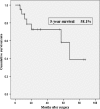The use of short segment free jejunal transfer as salvage surgery for cervical esophageal and hypopharyngeal cancer
- PMID: 24081534
- PMCID: PMC3868873
- DOI: 10.1007/s00268-013-2229-9
The use of short segment free jejunal transfer as salvage surgery for cervical esophageal and hypopharyngeal cancer
Abstract
Background: Salvage surgery after definitive chemoradiotherapy for cervical esophageal cancer and hypopharyngeal cancer remains a challenge because of the high rate of complications. The purpose of this study was to evaluate the safety and efficacy of free jejunal transfer as salvage surgery for cervical esophageal cancer and hypopharyngeal cancer after definitive chemoradiotherapy.
Methods: We enrolled eight patients with cervical esophageal cancer and 11 patients with hypopharyngeal cancer who underwent free jejunal transfer as salvage surgery following radiotherapy or chemoradiotherapy. In this study, we reviewed the surgical procedures, perioperative complications, and survival rates.
Results: The median duration of surgery was 514 min, and the median blood loss was 439 ml. In surgical procedures, the recipient vessels for the anastomosis of the free jejunum consisted of one artery and one vein (63 %), one artery and two veins (5 %), and two arteries and two veins (31 %). The postoperative morbidity rate was 57.9 % (11 patients), with six cases of partial necrosis of the tracheal margin and no cases of graft necrosis or postoperative in-hospital death. The overall 5-year survival rate after surgery was 58.1 %.
Conclusions: Our findings suggest that with careful attention to the potential development of necrosis of the tracheal margin, pharyngolaryngoesophagectomy and free jejunal transfer can be safely performed, even in patients who received radiotherapy or chemoradiotherapy.
Figures


References
-
- Pignon JP, Bourhis J, Domenge C, et al. Chemotherapy added to locoregional treatment for head and neck squamous-cell carcinoma: three meta-analyses of updated individual data. Lancet. 2000;355:949–955. - PubMed
MeSH terms
LinkOut - more resources
Full Text Sources
Other Literature Sources
Medical

